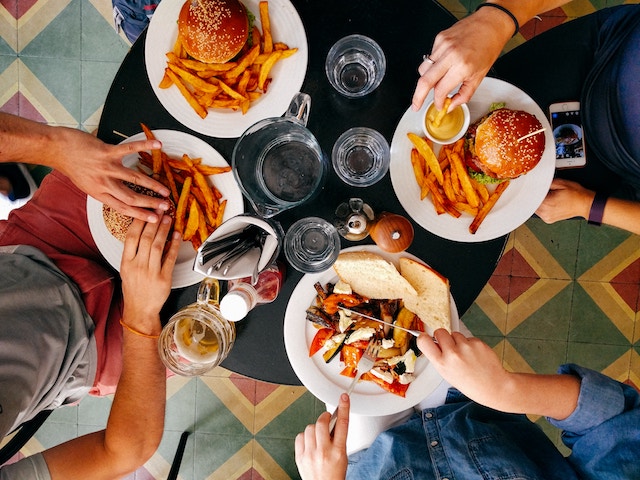
When we eat foods containing sugar and carbs, as a natural part of digestion, our blood sugar levels temporarily rise.
To respond to this surge of sugar into the bloodstream, the pancreas begins releasing insulin, which lowers the blood sugar back to normal levels.
The problems arise when we consume highly processed and refined foods. This means fast food, most packaged foods, foods made with white flour and white rice, white bread, foods with artificial sweeteners, foods with high-fructose corn syrup and preservatives, sugar-heavy drinks—you get the idea. These types of foods quickly raise blood sugar levels after you eat them.
Studies show that when blood sugar levels spike as a result of a processed meal, so do insulin levels and oxidative or free radical stress on the arteries. Several of these high spikes throughout the day, day after day, are a major offender when it comes to increased risk for Type 2 Diabetes and cardiovascular health concerns.
Choosing the right diet and lifestyle is an effective way to reduce dangerous after-meal blood sugar spikes. In one study, a diet high in minimally processed, high-fiber, plant-based foods such as vegetables and fruits, whole grains, legumes, and nuts markedly blunted the post-meal increase in glucose and triglycerides. Lean protein, vinegar, fish oil, tea, cinnamon, calorie restriction, weight loss, exercise, and low-dose to moderate-dose alcohol will do the same.
Strategies to Suppress High Blood Sugar Spikes after Meals.
Ayurveda recommends using healthy fats like ghee, coconut oil, nuts, and seeds to slow the absorption of sugar, caffeine, and processed and refined foods.
Drinking one’s coffee blended with coconut oil, grass-fed ghee, or butter has become a popular way to slow the delivery of caffeine into the bloodstream and curb the blood sugar spike. Doing so seems to deliver hours of caffeinated energy without a surge or crash.
Eating almonds or avocados with a higher carbohydrate meal (such as white bread, rice, or potatoes) can significantly lower the blood sugar spike from the carbohydrates. In one study, white bread was shown to increase after-meal blood sugar spikes, insulin, and free radical oxidation. When the white bread was eaten with 1/3 of a cup of almonds, the after-meal blood sugar and insulin spike, as well as free radical oxidation, were significantly reduced.
Plant-based fats, like almonds, nuts, coconut oil, and avocados, all seem to lower post-meal blood sugar spikes.
Animal fats, such as chicken and butter, seem to have the opposite effect. When chicken is eaten with carb-rich white rice, the after-meal blood sugar spikes increased. Ghee, also an animal-derived fat, was not studied in this report, but the suggestion from Ayurveda is that the removing of the milk solids in the making of ghee renders it somewhat similar in effect to plant-based foods like almonds, coconut, and avocado. More research is needed here to confirm this ancient wisdom.
The Takeaway.
When you find yourself having a “cheat day” and eating foods that you know are not the most wise or wonderful—try to eat the not-so-great food with an avocado, or add some nuts or seeds.
Indulging in ice cream or dark chocolate? Choose the ice cream or dark chocolate that contains almonds or other nuts.
Eating pasta? Cook in some pine nuts.
Having yogurt? Mix in some flax seeds.
Having toast? Spread on some almond butter.
Whenever possible, add a plant-based fat to your food to lower the dangerous after-meal blood sugar spikes, insulin, and free radical oxidation.
Disclaimer: While high after-meal blood sugar spikes can occur in otherwise healthy individuals who indulge in high-sugar meals or enjoy alcoholic beverages with their meal, if these become a regular occurrence, it may be a sign or symptom of pre-diabetes or Type 2 Diabetes. If you are concerned about whether you are vulnerable to developing either of these conditions, please contact your primary health care provider to discuss a holistic approach to addressing your concerns and to have your blood sugar levels tested.
Two Tests to Measure your After-Meal Blood Sugar Spikes.
- The test to measure your three-month average blood sugar levels is called a Hemoglobin A1C or HbA1C. This test actually measures the amount of glycation or blood sugar glucose in a blood sample. Optimal levels are below 5.4 percent.
- A two-hour Postprandial Glucose Test checks blood sugar levels two hours after you eat. Ideally, this number should stay below 125 mg/dL.
~
Author: Dr. John Douillard
Image: Dan Gold/Unsplash
Editor: Catherine Monkman
Copy Editor: Yoli Ramazzina
Social Editor: Khara-Jade Warren & Callie Rushton






Read 0 comments and reply